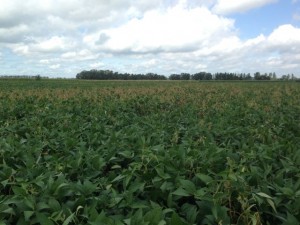Time to Start Preparing for White Mold Management in Soybean
Damon L. Smith, Extension Field Crops Pathologist, University of Wisconsin-Madison
Jaime Willbur, Graduate Research Assistant, University of Wisconsin-Madison
While many struggled to plant soybeans due to extremely wet weather this season, many fields we have observed are looking quite good. Soybeans planted in early May in the southwest portion of Wisconsin, may be flowering, or approaching the flowering growth stage. The flowering growth stages are a critical time to manage white mold, in-season. You can visit my previous posts dealing with white mold and favorable conditions, or view a fact sheet or video on the subject.
As you probably know, timing in-season fungicide sprays at the correct time during the soybean bloom period can be extremely difficult. To help solve this decision-making issue, a model was developed at the University of Wisconsin-Madison in conjunction with Michigan State University and Iowa State University to identify at-risk regions which have been experiencing weather favorable for the development of white mold apothecia. This model predicts when apothecia will be present in the field using combinations of 30-day averages of maximum temperature, relative humidity, and wind speed. Using virtually available weather data, predictions can be made in most soybean growing regions. Based on these predictions, a map is generated under three scenarios (non-irrigated soybeans, soybeans planted on 15″ row-spacing and irrigated, or soybeans planted on 30″ row-spacing and irrigated). The maps are colored to show the likelihood of apothecial presence within a region. White areas indicate the model is inactive and risk of apothecia in the field is likely low. Gray areas indicate that apothecia might be present, but likelihood of apothecial presence is less than 5%. Blue indicates a low risk (5 to <15% chance), yellow a moderate risk (15 to <30% chance), and red areas indicate a high risk (30% or higher chance). Model predictions must be combined with soybean growth stage and canopy characteristics to aid in timing of fungicide sprays. If the model is predicting high risk (red) in your area for your planting scenario, the soybeans are flowering, and the canopy is somewhat closed, then the white mold risk is elevated. If your fields are at-risk, we recommend to consult your local extension personnel or resources for the best in-season management options for your area. To view and download a handy user guide for the model, CLICK HERE.
For Wisconsin soybean growers, regular updates and commentary regarding risk of white mold can be found on this blog. Color coded, state-wide maps will be posted and our recommendations will accompany these posts. So be sure to check back regularly or subscribe to the blog to receive an automatic e-mail update when a new post has been added. You can subscribe via the window immediately to the right of this window. The first post for 2017 can be viewed by clicking here.
If you have decided to spray soybeans for white mold, what are the best products to use? Over the last several years we have run numerous fungicide efficacy trials in Wisconsin and in conjunction with researchers in other states. Fungicides that have performed well in multi-state studies can be found in the 2017 version of the Soybean Fungicide Efficacy Table. In Wisconsin, we have observed that Endura applied at 8 oz at the R1 growth stage performs well. We have also observed that the fungicide Aproach applied at 9 fl oz at R1 and again at R3 also performs comparably to the Endura treatment. Other fungicide options also include Omega and Proline. You can view results of past fungicide evaluations by CLICKING HERE.
For even more detailed information about white mold you can visit the Crop Protection Network page on white mold . You can also find more information about white mold by clicking here and scrolling down to the white mold section.



